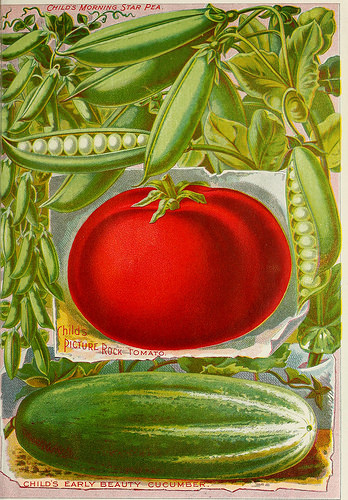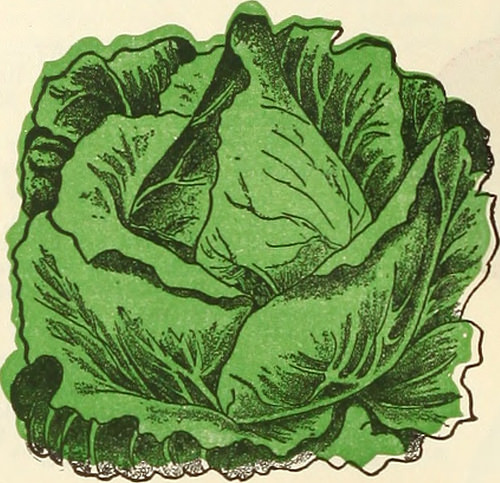Check out these vegetables online images:
Image from page 16 of “Childs’ rare flowers, vegetables & fruits for 1895” (1895)

Image by Internet Archive Book Images
Identifier: childsrareflower00john_0
Title: Childs’ rare flowers, vegetables & fruits for 1895
Year: 1895 (1890s)
Authors: John Lewis Childs (Firm) Henry G. Gilbert Nursery and Seed Trade Catalog Collection
Subjects: Commercial catalogs Seeds Nurseries (Horticulture) Catalogs Seeds Catalogs Flowers Catalogs Vegetables Catalogs Fruit trees Catalogs John Lewis Childs (Firm) Commercial catalogs Nurseries (Horticulture) Seeds Flowers Vegetables Fruit trees
Publisher: Floral Park, N.Y. : John Lewis Childs
Contributing Library: U.S. Department of Agriculture, National Agricultural Library
Digitizing Sponsor: U.S. Department of Agriculture, National Agricultural Library
View Book Page: Book Viewer
About This Book: Catalog Entry
View All Images: All Images From Book
Click here to view book online to see this illustration in context in a browseable online version of this book.
Text Appearing Before Image:
we hope all will take it, for it is afine collection of extni choice nardy plants, which whenonce planted win bloom profusely year after year with littleor no care. Plant it in honor of The Mayflowers tnyears of existence. The Collection Is composed of the fol-lowing ten extra choice plants:1 Iris Kaempferi, Gold Bound, finest of all Japan Iris See Pagp 29 1 Iris Germanlca, Mad. Cherai, finest German Iris 104 1 Clematis Davldlana, a beautiful bush Clematis 1241 Platycodon Grandifiora, an elegant garden plant 105 1 Tritoma Gmndiflora, an exquisite plant for late summer and fall blooming 100 1 Arundo Donax Variegata, the finest of all ornamental grasses 124 1 Day Lily, variegated; an exquisite hardy fol-iage plant 104 1 Tree Hollyhock, a superb shrub 107 1 Sweet Pea Shrub, lovely bevond description 107 1 Filbert, Kentish Cob, elegant nut-bearing .siirub 39 These ten plants amount to 81.75 at regular rates, by wewill send them by mail, postpaid, to any Mayflower Kib-scriber for only 75c.
Text Appearing After Image:
5^r^^ A J[/oi;id^rfuI T f(^(^e:ahe^. IN every vegetable garden in the country, no matter hovir small, ope vnll always find Peas, Tomatoes andCucumbers. It is therefore exceedingly gratifying to us that we can offer a new variety of each of thesethree important vegetables, the merits of which are great enough to eclipse all others and rapidly establishthem in all gardens. The Cucumber is now offered for the first time, and is the earliest and best of all earlysorts. The Pea was introduced last year and is the earliest known variety, notwithstanding it is a wrinkledvariety of good size, and possesses the exquisite flavor of late varieties—a quality which has never before beenfound in an early sort. The Tomato was introduced the year previous, and while being one of the very earliestit bears profusely till frost, and its beautiful, smooth and uniform shape and unsurpassed quality, makes itsuperior to any other. It costs no more to grow the best varieties than it does poor ones, and
Note About Images
Please note that these images are extracted from scanned page images that may have been digitally enhanced for readability – coloration and appearance of these illustrations may not perfectly resemble the original work.
Image from page 7 of “Annual catalogue : 1916 machinery, fertilizers, seeds, etc” (1916)

Image by Internet Archive Book Images
Identifier: annualcatalogue11916cmwo
Title: Annual catalogue : 1916 machinery, fertilizers, seeds, etc
Year: 1916 (1910s)
Authors: C. M. Woolf & Co. Inc Henry G. Gilbert Nursery and Seed Trade Catalog Collection
Subjects: Seeds Catalogs Nurseries (Horticulture) Catalogs Vegetables Catalogs Fruit Catalogs Gardening Equipment and supplies Catalogs
Publisher: Washington, D.C. : C.M. Woolf & Co.
Contributing Library: U.S. Department of Agriculture, National Agricultural Library
Digitizing Sponsor: U.S. Department of Agriculture, National Agricultural Library
View Book Page: Book Viewer
About This Book: Catalog Entry
View All Images: All Images From Book
Click here to view book online to see this illustration in context in a browseable online version of this book.
Text Appearing Before Image:
ans Garden SWISS CHARD (The City Mans Garden).—Also called Cut andCome Again Spinach. This vegetable gives maximum returns for littlecare and space; it yields a constant crop from July to Winter. Theleaves are used for greens the same as Spinach or beet tops; they areequal in quality and easier to prepare than spinach, and far superior tobeets. Sow early in Spring, in rows 16 inches apart, and thin out to 6inches apart in the rows. It can be used all Summer when spinach isnot available. Later the leaves grow very large, with broad, flat, purewhite stems, and mid-ribs, which may be cooked like Asparagus or madeinto very good pickles. As it grows, thin out for use and keep clear ofweeds. Good cultivation increases the tenderness of the leaves. LUCULLUS SWISS CHARD—A new Moss Curled sort. Very largeleaves. The mid-ribs are very broad and form a good substitute forasparagus during the Summer months. Pkt., 10c; oz., 15c; % lb., 35c;1 lb., .00. PRICES SUBJECT TO CHANGE WITHOUT NOTICE.
Text Appearing After Image:
Swiss Chard. C. M. WOOLF & CO., Inc., 1005 B Street, N. W., Washington, D. C. 5 CAULIFLOWER German. Blumentohl Spanish, Coliflor French, Choufleur One ounce will sow a bed of 40 square feet, and produce about 3,000 plants. CULTURE.—When grown to perfection this is a most delicious vegetable, and well repays generous treatment in culti-vation. With a deep rich soil and an abundance of moisture, which in dry seasons must be applied artificially, Cauliflowercan be grown well. The cultivation is similar to that of the cabbage. For early fall crops sow in May, and transplant inJune, in rows of 4 feet apart, setting the plants 2 feet apart in the rows; water frequently if the ground is dry. Frequent hoeing and a liberal supply of rich liquid manure, to keep up a continuousand rapid growth, will produce splendid heads of the most delicate flavor. Itfacilitates blanching if the leaves are gathered loosely together and tied overthe top of the head to protect from the sun. Cut before the
Note About Images
Please note that these images are extracted from scanned page images that may have been digitally enhanced for readability – coloration and appearance of these illustrations may not perfectly resemble the original work.
